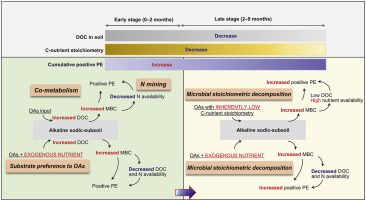Soil Biology and Biochemistry ( IF 9.8 ) Pub Date : 2020-04-05 , DOI: 10.1016/j.soilbio.2020.107800 Yunying Fang , Bhupinder Pal Singh , Mark Farrell , Lukas Van Zwieten , Roger Armstrong , Chengrong Chen , Mohammad Bahadori , Ehsan Tavakkoli

|
Application of organic amendments (OAs), nutrients and gypsum to sodic subsoils is of great interest to improve soil functionality and crop yield. However, controversy remains about the impact of the priming effect (PE) on native soil organic carbon (SOC), and the mechanisms governing the dynamics of the PE by OAs (with variations in nutrient stoichiometry). To address these gaps in knowledge, this nine-month study applied C4-plant-derived OAs in a C3-plant-derived soil at 6.2 g C kg−1 soil, with and without the exogenous supply of nutrients (nitrogen and/or phosphorus) or gypsum. Across the treatments, the cumulative PE was between 135 and 475 mg CO2–C kg−1 soil over the nine months, equivalent to 2.3–8.2% of native SOC loss. In the first two months, the positive PE by the OAs could be attributed to co-metabolism and nitrogen (N) mining. These theories were supported by (i) the enhanced growth of microbial biomass associated with increased soil labile C (such as dissolved organic C); and (ii) the decreased soil mineral N availability, likely via microbial N immobilization, particularly with the inputs of sorghum stubble or sugarcane bagasse. Towards the end of the incubation, the relative PE (i.e., PE ÷ SOC mineralization in the control soil) was higher in the OA treatments (sorghum stubble and sugarcane bagasse) where nutrients were added to lower the C: nutrient stoichiometric ratios. These results support the theory of microbial stoichiometric decomposition of SOC, which may have become the dominant mechanism of PE over time. The application of gypsum, together with OAs (sorghum stubble or sugarcane bagasse), did not significantly change the magnitude or direction of the PE. In conclusion, the significant native SOC losses and N immobilization induced by the OAs, particularly where we balanced the nutrient stoichiometric ratios, indicate the vulnerability of subsoil SOC, and hence the potential of C sequestration in a sodic subsoil following the application of OAs may be limited.
中文翻译:

有机改良剂的平衡营养化学计量,可增强结构不良的苏打底土中的碳引发作用
有机改良剂(OAs),养分和石膏在苏打底土上的应用对提高土壤功能和作物产量具有极大的兴趣。然而,关于引发效应(PE)对天然土壤有机碳(SOC)的影响以及通过OAs控制PE动力学的机制(营养成分化学计量的变化)仍存在争议。为了解决这些知识差距,这项为期9个月的研究在6.2 g C kg -1的土壤中,在C 3植物衍生的土壤中施用C 4植物衍生的OA ,有无外部养分供应(氮和/或或磷)或石膏。在所有处理中,PE的累积累积量在135至475 mg CO 2 –C kg -1之间在这9个月中,土壤损失相当于本机SOC损失的2.3–8.2%。在最初的两个月中,OA带来的积极PE可能归因于共同代谢和氮(N)开采。这些理论得到了以下方面的支持:(i)与土壤不稳定碳(例如溶解的有机碳)增加相关的微生物生物量的增长;(ii)可能通过微生物固氮,特别是在高粱茬或甘蔗渣的投入下,土壤矿物质氮的有效性降低。孵化结束时,相对PE (即,在OA处理(高粱茬和甘蔗渣)中,控制土壤中的PE÷SOC矿化度较高,其中添加了养分以降低C:养分的化学计量比。这些结果支持了SOC的化学计量分解理论,随着时间的推移,它可能已成为PE的主要机理。石膏和OAs(高粱茬或甘蔗渣)一起施用不会显着改变PE的大小或方向。总之,OAs引起的显着的天然SOC损失和N固定化,特别是在我们平衡养分化学计量比的情况下,表明了地下SOC的脆弱性,因此,应用OAs后钠盐在钠土中的固存潜力可能是有限。











































 京公网安备 11010802027423号
京公网安备 11010802027423号